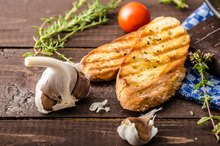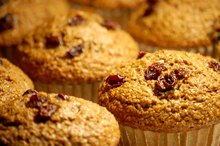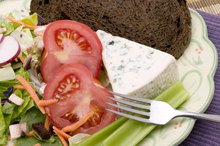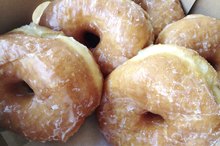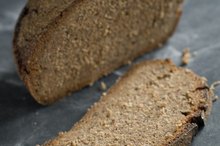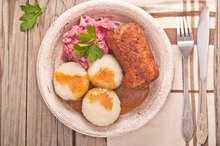Nutrition Information on Challah Bread
Challah bread, also known as Sabbath bread, has a soft texture and egg flavor. It is traditionally braided, and the crust is washed with egg. This bread may have raisins and can be sweet or savory. This bread figures prominently in the Jewish religion and is often served for the Sabbath. People eat it plain, use it as sandwich bread or use it to make French toast.
Calories and Carbohydrates
A 2-ounce slice of challah bread contains roughly 160 calories, according to Bread Alone Bakery's website. Based on a 2,000-calorie diet, this accounts for 7.5 to 8 percent of the calories you may include in your meal plan. Adding butter may contribute 36 calories; adjust your total calories accordingly. Eating a slice of challah bread as a snack fits into the target calorie range -- snacks should contain less than 200 calories, according to the Cleveland Clinic. Challah bread is rich in carbohydrates -- it contains 27 to 30 grams per 2-ounce slice. This amounts to 21.5 to 23 percent of the 130 grams of carbohydrates recommended for daily consumption by the Institute of Medicine. The carbohydrates in your diet serve as energy for your body, particularly your brain and nervous system. Consuming too many carbohydrates may lead to becoming overweight, so monitor your diet to make sure you ingest recommended levels.
Proteins and Fat
Calories in Panini Bread
Learn More
A 2-ounce serving of challah bread provides you with 6 grams of protein. The Institute of Medicine recommends consuming 46 to 56 grams each day. The McKinley Health Center notes the majority of Americans consume enough protein in their daily diet. You need protein as a source of energy, as well as to maintain your immune function and help your body repair tissues. Depending on how the bread is made, it can contain up to 4 grams of fat per 2-ounce slice. You should limit your intake of fat to 20 to 35 percent of the calories you eat daily, or 44 to 78 grams. A portion of challah bread may get up to 23 to 24 percent of its calories from fat. Including too much fat in your diet may result in an increased risk for obesity and obesity-related health problems like heart disease and diabetes.
Minerals
Two ounces of challah bread has roughly 10 percent of the daily recommended value of iron. Your body requires 8 to 18 milligrams of this mineral each day to build red blood cells. Without adequate amounts of iron, you may develop anemia. This condition can cause headaches, fatigue, paleness and breathing trouble.
Considerations
Raisin Bran Muffin Calories
Learn More
Including challah bread in your diet may require you to monitor your meal plan for sodium -- a 2-ounce slice contains around 260 milligrams. The American Heart Association notes that you should consume no more than 1,500 milligrams of sodium per day. Ingesting more than this on a regular basis may result in health problems like high blood pressure.
Comparisons
Challah bread contains roughly the same number of calories and carbohydrates as white bread, but it is higher in fat and protein. A 2-ounce slice of white bread contains 1.8 grams of fat, and a 2-ounce slice of whole-wheat bread has 1.9 grams of fat, compared to up to 4 grams for the same size portion of challah bread. A slice of white bread provides 4.3 grams of protein; whole-wheat bread -- 7.06 grams and 2 ounces of challah has 6 grams.
Related Articles
References
Resources
Writer Bio
Nicki Wolf has been writing health and human interest articles since 1986. Her work has been published at various cooking and nutrition websites. Wolf has an extensive background in medical/nutrition writing and online content development in the nonprofit arena. She graduated with a Bachelor of Arts in English from Temple University.
